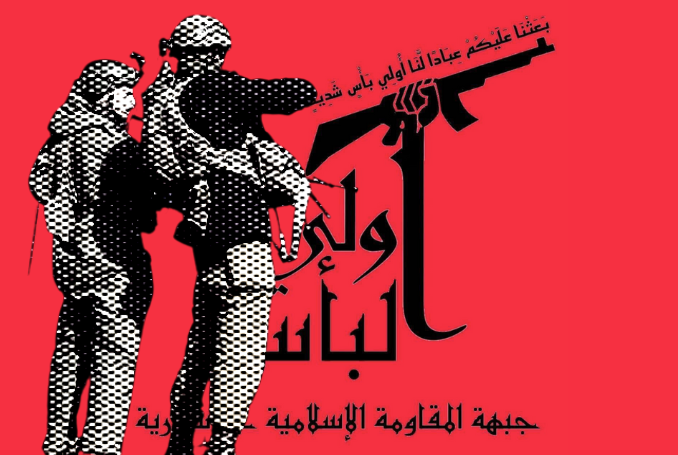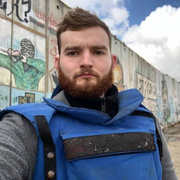
The mobilization of local armed forces surrounding Dara’a has evidently now reached a new height, and if things continue to escalate, there is now reasonable grounds to believe that this could develop into a formidable resistance movement.
On Wednesday evening, local southern Syrian militia forces mobilized to confront an Israeli military incursion into the Western countryside near Dara’a city. An Israeli military convoy was subjected to an ambush, clashes broke out close to the demarcation line between both sides, and a popular uprising appears to be brewing. This could be the start of the Southern Syrian resistance front.
On April 2, a sudden mobilisation occurred after calls for resistance from Mosque loudspeakers in the Nawa and Tasil areas, in the Dara’a countryside of southern Syria. Hundreds of men took up arms, preparing to thwart another illegal Israeli incursion that threatened their livelihoods.
Things really heated up after Israeli telegram pages, media, and websites began reporting on a “security event” in Syria, which is a codeword for an attack that has inflicted casualties on Israeli forces.
The Israeli media began reporting on injuries and potential deaths, as well as settler websites and Telegram pages published calls to “pray for our soldiers”, later leaking information about several deaths and injuries.
—❗️🇮🇱/🇸🇾 BREAKING: Unknown armed fighters have launched an ambush on an IDF patrol in Daraa, southern Syria pic.twitter.com/TgDJluoYXD
— The Resistance (@TopGResistance) April 2, 2025
Pairing this information together with what Syrian local media accounts had reported, it appears as if an Israeli convoy was targeted, inflicting a number of casualties, which then forced the Israeli army to send a rescue convoy accompanied by attack helicopters.
Two Israeli surveillance drones were also reportedly shot down, and a series of clashes broke out between Israeli and local Syrian militia groups. As Israeli forces retreated back into the illegally occupied Golan Heights region of Syria, artillery and helicopter strikes pummeled areas surrounding a number of Syrian villages, killing 11 and injuring at least 20, of whom 5 were seriously wounded.
A joint funeral ceremony was held for those Syrians killed the following morning, which drew the participation of thousands. Although the Israeli press had already released reports about soldier casualties, the infamous military censor restricts their reporting on such issues, and on Thursday morning, the army announced that there were no casualties and avoided any mention of drones, claiming that the forces briefly came under fire.
Why the Israeli army’s claims make little sense is due to their reaction to the ambush on their convoy. In two previous incidents, Israeli convoys had also come under direct attack by Syrians who were attempting to repel their illegal advances, yet they did not bring down such force nor send reinforcements to rescue their soldiers as we saw in this case. Israel also has a track record of constantly changing its casualty statistics.
The mobilization of local armed forces surrounding Dara’a has evidently now reached a new height, and if things continue to escalate, there is now reasonable grounds to believe that this could develop into a formidable resistance movement.
The actions taken by these armed groups also have the markers of a completely organic force, as there was even an incident reported where two separate Syrian groups had mistaken each other for Israeli soldiers and opened fire on one another, demonstrating that each area had mobilised forces alone without establishing lines of contact with others.
Syrian Resistance. Fighters of the Islamic Resistance Front in #Syria launch an ambush on an Israeli patrol in Daraa, southern Syria. pic.twitter.com/4E14eBpPAQ
— tim anderson (@timand2037) April 3, 2025
Something Had To Give
Following the fall of former Syrian President Bashar Assad on December 8, 2024, the nation was instantly plunged into an inevitable crisis.
While the new government was to be overtaken by Abu Mohammed al-Jolani, who would begin using his given name, Ahmed al-Sharaa, placing Hayat Tahrir al-Sham in de facto control of Damascus, the foreign powers who had long sought regime change in Syria instantly initiated their plans to implement a number of agendas.
The most aggressive foreign regime was Israel, which instantly used the fall of Syria’s defence forces as an excuse to carry out its largest ever air campaign that eliminated a large portion of the nation’s military assets.
Israeli Prime Minister Benjamin Netanyahu also bragged about the collapse of the Syrian government, attempting to take credit for it, announcing that his military would be conducting a new land grab.
Israel announced the end to the 1974 disengagement agreement that took effect between Tel Aviv and Damascus following the 1973 war, which started when former Syrian President Hafez al-Assad launched a surprise offensive, along with Egypt, to reclaim their lands that were illegally occupied in the June 1967 war.
Everything You Need to Know About Qatargate and Netanyahu’s Scandal
For decades, the Israelis sought to expand their “security buffer zone” deeper into Syrian territory, implementing a number of steps towards achieving this since 2013.
In fact, a number of proposals were set forth and debated between the United States, Jordan, and Israel, starting from 2013, which is also when the Israelis began supporting at least a dozen Syrian armed groups in the south of the country.
Of course, Israel’s support for the Syrian opposition groups, including al-Nusra [now Hayat Tahrir al-Sham], was conditional, and the goal was simply to achieve a situation like we see today.
Ahmed al-Sharaa’s forces in Syria, at the time of the fall of Assad’s rule, were estimated to be a combined force of no more than 35,000 men, who were ill-equipped to deal with stabilising Syria, let alone fighting Israel.
The largest group was Hayat Tahrir al-Sham (HTS), yet the other groups also played a role in what was initially only supposed to be an offensive to capture Aleppo. In fact, al-Sharaa’s men even had to receive support from Ukrainian drone operators and Turkish forces. When they captured their first airfield in Aleppo, HTS fighters were filmed looking up YouTube videos on how to fly helicopters.
On top of this, many of the armed factions that were formally based in Syria’s northern Idlib Province, were divided and routinely engaged in infighting, one of the major issues being the range of groups with varying political, ethnic and religious views, in addition to the presence of a large number of foreign fighters. These groups taking over the entire country only exacerbated the internecine fighting.
Beyond the Headlines: What Lies behind the Anti-Hamas Protests in Gaza?
All of this is important context as to why no action has been taken by the authorities in Damascus to combat Israel’s months long campaign of airstrikes, civilian massacres, ethnic cleansing of Syrians and attempts to use militia forces, such as Druze militias situated around the southern city of Suwayda, to work towars implementing their plot to seize the south of Syria.
Prior to the outbreak of clashes in southern Syria this Wednesday, another major development occurred. Israel decided to completely wipe out the T-4 military airbase in Homs, in addition to striking targets throughout five points across Syria, which the Israeli army estimated had killed around 300 people.
Three Turkish engineers were also killed in the Israeli assault, which was seen as a message to Ankara that Tel Aviv will not tolerate Turkish military presence in Syrian territory.
While Turkiye is not likely to militarily engage directly with Israel, these kinds of aggressive assaults may perhaps contribute to the growth of a Syrian resistance front in the south, which would actually serve as an asset for the governments in Damascus and Ankara, so long as it doesn’t grow too powerful.
Even in the case that the southern front does expand, the fact that neither the leadership in Turkiye, nor Syria, will be involved, gives them plausible deniability and there is a possibility they will allow for the front to expand instead of combating it, as a strategy to try and put Israel in its place.
Leaked Messages Reveal what US Doesn’t Want You to Know about Its War Plans
The Fighting Spirit of the South
The predicament of southern Syria’s Dara’a is of central importance to the very fate of the Syrian Arab Republic as a whole. Dara’a is the area where the first anti-government protest movement emerged, which ended up spiralling into Syria’s devastating civil war.
The south of Syria has long been the cradle of resistance and popular uprisings; after all, it was from there that the Great Syrian Revolt against French colonial rule in 1925 was sparked under the leadership of Syrian-Druze leader Sultan al-Atrash.
With Dara’a in particular, there is an element of Darawi pride that serves as a nuisance to any foreign invaders. Under the former government of Bashar al-Assad, many of the armed groups that had opposed the army were even negotiated with in the end, which enabled former opposition fighters to remain in the area under agreements.
Then, when the forces of Ahmed al-Sharaa attempted to enter Dara’a, the local forces only enabled them to enter the city in order to align with the government, but prevented HTS fighters from heading into the surrounding villages. Another important point to note is that following the collapse of what was once the Syrian Arab Army (SAA), many experienced army personnel and officers headed back to their villages in the Dara’a area.
While almost all of the Palestinian resistance factions, along with Hezbollah and Yemen’s Ansarallah, praised the Syrian stand to protect their villages against Israel, inside Syria itself the only real support the fighters have is from local actors and a group that has emerged calling itself The Islamic Resistance Front in Syria (Jabhat al-Moqowameh al-Islamiyyah fi Souriya).
Authoritarian Crackdown on Palestine Advocacy Meets Legal Challenges
This group bears a logo similar to that of Hezbollah and IRGC-aligned armed groups, yet it is not clear whether this is simply a social media stunt or whether such a group does exist. The only potential drawback of this group would be it being interpreted as an Iranian project, which could then justify the Syrian government to help the Israelis in destroying the resistance in the south.
Despite all of this, the takeaway here is that, following the refusal of anyone else to aid them, the people of Dara’a are beginning to take it upon themselves to resist Israel using the limited weapons they possess. In response, Israeli Defense Minister, Israel Katz, has threatened to take direct action to completely demilitarise southern Syria and place it under its de facto rule, which will guarantee further resistance.
The more civilians Israel decides to murder in southern Syria, the more the appetite for resistance will grow. This is especially the case at this time, due to the impact that Israel’s genocide against the people of Gaza has had on the Arab World’s collective psyche.
Depending on how the events continue to pan out, which largely hinges on Israeli actions, it is not out of the realm of possibility that southern Syria could end up turning out very much like southern Lebanon.
(The Palestine Chronicle)

– Robert Inlakesh is a journalist, writer, and documentary filmmaker. He focuses on the Middle East, specializing in Palestine. He contributed this article to The Palestine Chronicle.
(Except for the headline, this story has not been edited by PostX News and is published from a syndicated feed.)
